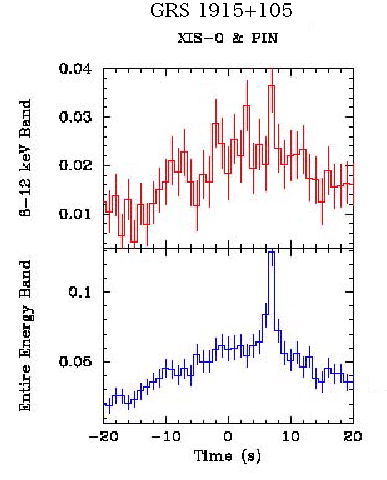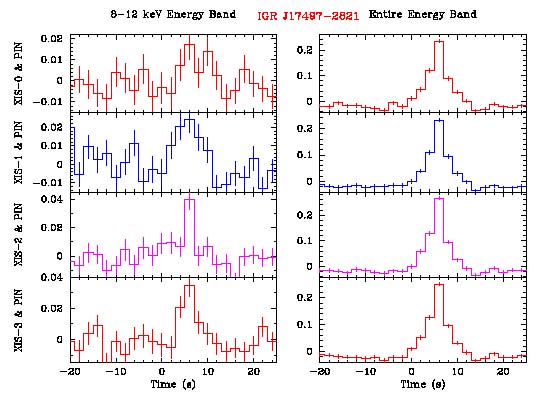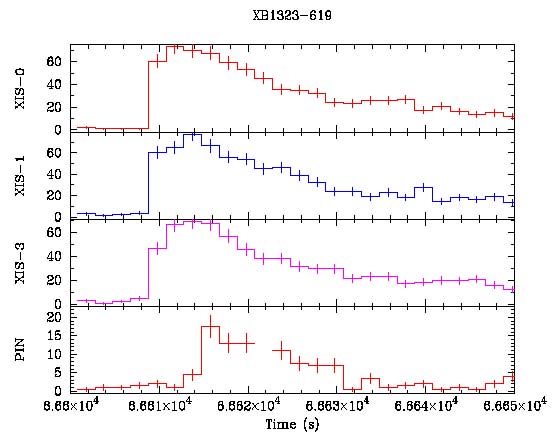Time Assignment Error of XIS (rev 1.2/1.3)
2007 Apr 26 by the XIS Team, edited by the GOF
1. Summary
There is a systematic error in the XIS time assignment in rev 1.2 and
1.3 pipeline products. Because of this systematic error, XIS time
is shifted compared to the HXD time by 6 sec
(THXD=TXIS + 6 sec) when 1/4
window option is used and 7 sec
(THXD=TXIS + 7 sec)
when 1/8 window is used. Although not directly measured, the nature
of the error indicates that XIS data taken in normal mode without
a window option should not be affected. We ask the users to
note this XIS time assignment error when conducting timing analysis
with the XIS data. This time assignment error will be corrected in
Version 2.0 processing.
In what follows, we explain how the time assignment error was measured and how we can correct it.
2. Calibration method of XIS time assignment
Time assignment of Suzaku HXD is calibrated using the Crab
pulsar. Absolute time assignment of HXD is known to be better
than a few hundred micro seconds. Because the time
resolution of XIS is of an order of seconds in normal mode, we
calibrated the XIS time assignment by referring the HXD PIN data.
We used data from bright X-ray binaries and took a cross-correlation
between XIS and PIN light curves to determine the offset of XIS time
assignment compared to PIN. If possible, we directly
compared the XIS and PIN light curves.
We used the XIS data with 1/4 window or 1/8 window options.
Although we tried to calibrate the normal mode data without options, we
could not find appropriate data, which had large variability and good
statistics in both XIS and PIN. Thus the current
calibration is restricted to the data with 1/4 window or 1/8 window
option.
3. Revision of data
We used the revision 1.2 pipeline products. Because there
was no change in the XIS time assignment between the revisions 1.2 and
1.3 products, the XIS
time offset should be same for both revisions of products.
However, it was different in rev 0.7 or earlier. Thus, the
results in this page are not applicable to the rev 0.x products.
4. Results: 1/8 window option
XIS data have a time resolution of 1 sec when 1/8 window option is
applied. We made the XIS light curve in 1-sec bin and
calculated a cross-correlation with the PIN light curve also made with
1-sec bin. We calculated the cross-correlation in both the
total energy band and in the overlapping energy range of 8-12
keV. This was to check the effect of energy dependent time
lag intrinsic to the source. However, we found that the
results in the total band and 8-12 keV were consistent in all cases.
(1) Cyg X-1
Cyg X-1 is a proto-type black hole candidate, and is well known for its
rapid and large time variations. The source was observed in
2005 Oct 5 with 1/8 window option. Cross-correlation functions
between XIS and PIN are shown below for XIS2 and XIS3 and for the total
band and the 8-12 keV band. Here, a positive time las means that
PIN lags behind XIS. An offset of +7 sec is very clear in both
8-12 keV band and in the total band. This means that the hard lag
intrinsic to the source is negligible in the current analysis.

(2) 4U1626-67
4U1626-67 is an accretion-powered X-ray pulsar with a pulse period of
7.7 sec. It was observed in March, 2006, with 1/8
window option. Cross-correlation functions are shown below in
both
the 8-12 keV and the total bands separately for XIS1 and
XIS2. Because the source is a pulsar of 7.7 sec, the
cross-correlations have peaks separated by 7.7 sec.
However, another peak is clearly seen at +7 sec, which may be originated
from the random variations of the source.

(3) GRS1915+105
GRS1915+105 is one of the black hole candidates accompanying
relativistic jets, often referred to as micro-quasars. The
source is known to show rapid and violent time variations. It was
observed in October 2005 with 1/8 window option. In addition to
the window option, a burst option (0.1 sec) was also applied to XIS1
(the BI sensor) to prevent the possible telemetry
saturation. Thus we used only the data from the
FI sensors. Calculated cross-correlation
functions is shown below for XIS0. Although the data
statistics are poor in the 8-12 keV band, a clear peak is seen at +7
sec offset in the total band.

5. Results: 1/4 window option
XIS data have a time resolution of 2 sec when 1/4 window option is
applied. We made the XIS light curve in 2-sec bin and
calculated a cross-correlation function with the PIN light curve also
made with
2-sec bin. We calculated the cross-correlation in both the
total energy band and in the overlapping energy range of 8-12
keV.
(1) IGR J17497-2821
This is a hard X-ray transient discovered by INTEGRAL. Suzaku
made a TOO observation of the source in Sep 25-26, 2006.
The source had a hard spectrum, extending well above 100 keV, typical
for the low/hard state of a black hole candidate.
We observed the source applying both 1/4 window and 1-sec
burst options to avoid the photon pile-up. Because the
effective exposure of 1-sec covered the latter half of the 2-sec
window in this case, the burst option introduced an additional
systematic shift of -0.5
sec between XIS and PIN data. We show the calculated
cross-correlation functions below. Although the statistics are
poor for the data in 8-12 keV band, both the 8-12 keV and the total
band data are consistent with +6 sec offset. The peak in the
total band data shows slight asymmetry around +6 sec. This may
be interpreted due to the additional -0.5 sec offset introduced by the
window option.

(2) XB1323-619
This is a low-mass X-ray binary of a moderate luminosity showing both
dipping and bursting activities. An X-ray burst
usually shows a sharp rise. Thus we directly compared the XIS and
PIN light curves to quantify the time assignment error of
XIS. The source was observed in January 2007 using the 1/4
window option. XIS and PIN light curves of one of the
X-ray bursts are sown below. Note that XIS2 did not operate
during the observation. Because of the spectral evolution of the
burst, XIS and PIN light curves are somewhat different. However,
if we compare the onset of the burst, an advance of XIS time by 6 sec
compared to PIN is clear.

6. How to correct the XIS time assignment error
One can modify the header keyword in the event files to correct the
XIS time assignment error. The origin of time is defined by
the keyword "MJDREF?" in the event files as shown below:
<< An example of the header keywords >>
MJDREFI = 51544 / MJD reference day MJDREFF = 0.00074287037037037 / fractional part of the MJD reference (64.184 s)MJD is split into the integer and decimal parts. You can add 7 sec or 6 sec (8.102E-5 or 6.944E-5) to "MJDREFF" to correct the time assignment error. Note that you need to correct the keyword for all the extensions.
If you have any questions concerning Suzaku, visit the Feedback form.

